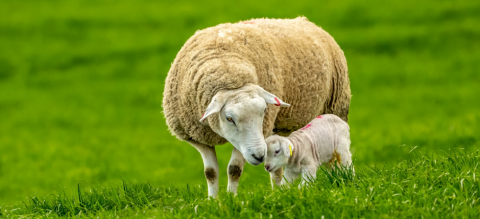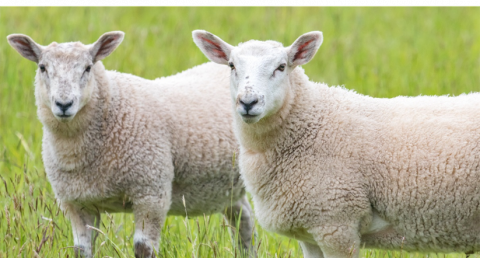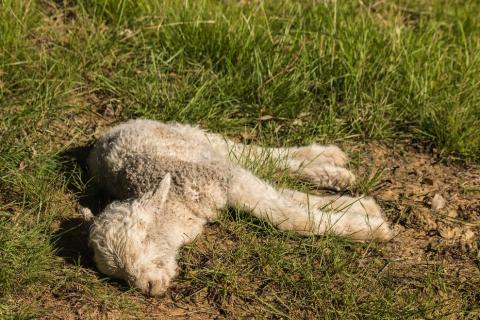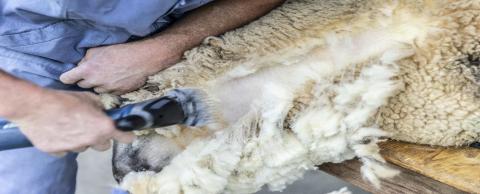17 June 2020
Dr David Cutress: IBERS, Aberystwyth University.
- Ewe lamb breeding is a strategy that has long been discussed for its potential in improving the efficiency and profitability of the sheep farming sector
- Currently, ewe lamb breeding is under-utilised despite perceived benefits, due to the lack of stable and reliable reproductive performances achieved when breeding younger ewes
- Renewed interest in ewe lamb breeding is leading to research aimed at combating reproductive performance deficits via genetic analyses and nutritional strategies amongst other approaches
Introduction
Sheep farming is an important industry globally and particularly in the UK and Wales. In the UK approximately 34 million sheep are present within the sector producing 288,600 tons of meat, with approximately a fifth of all sheep meat being produced in Wales. For the UK this accounts for around £376 million in exports as well as the sector employing 34,000 individuals on farms and further 111,405 jobs in related industries, contributing £291.4 million to UK employment. Alongside this, there is an increasing drive towards more efficient and sustainable farming, both globally and in the UK, and sheep production systems must be as efficient as possible to increase profits and reduce climate impacts per head of sheep. One method that has been discussed from the 70s onwards, for its potential towards increasing production (potentially within the same environmental footprint), is the breeding of young ewe lambs/hoggets to achieve first lambing as yearlings. The notion behind this practice is that ewe lambs can undergo puberty and achieve oestrus between the age of 7 – 10 months, yet despite this, the majority of ewes are not bred until they are two-teeth or 18 – 20 months of age. The common practice within the sheep industry is to maintain sheep up to 6 years of age before replacing, therefore, there is a potential for 5 breeding periods. As such including an extra period of breeding at 1 year of age improves the productivity of the industry as a whole by 20% (though this is a simplistic representation of a more complex calculation). In the UK figures from 2009 suggested that only 332,000 ewe lambs were bred in England which equalled around 40% of the required female replacements for lowland English flocks. International trends appear to be similarly low with <40% ewe lambs being bred in New Zealand.
The breeding of ewe lambs has been discussed for over 40 years yet there is a clear lack of uptake despite potential production gains, therefore, there must be barriers or a negative perspective of this lambing system. This article will discuss some of the potential benefits of breeding young ewe lambs, the barriers to breeding ewe lambs and the current research focuses which could benefit this practice.
What are the benefits of breeding ewe lambs?
The breeding of ewe lambs can have several benefits to the lambing industry as a whole, these include increased lifetime profitability, reproductive performance, an earlier selection tool for ewe replacements, reduction in generation interval time when selecting for breeding/replacements, reduced biosecurity risks associated with purchasing external replacement ewes as well as potential climate impact reductions.
Lifetime profitability and increased farm profitability is one of the simplest aspects of breeding ewe lambs to understand. By increasing the number of breeding cycles within a sheep’s lifetime you increase the profits gained from selling offspring for meat. Previous modelling studies have suggested shifting the number of ewes which achieve puberty and are bred as yearlings from 25% to 100% on a New Zealand hill farm could improve profits by 6%, and an Australian model, looking at multiple reproductive improvements, demonstrated improving the reproduction of ewe lambs could lead to a pay-off of AU$332 million across the industry (the only reproductive aspect which gave higher pay-offs was improving survival of twin born lambs). Reproductive performance, therefore, directly factors into lifetime profitability as several previous studies have suggested that those ewe lambs which show oestrus early (which is likely only detected if ewe lambs are in a breeding scheme) have increased lambing percentages as two-tooth ewes regardless of whether they produce lambs or not, thus these ewes can be selected for rather than sold or culled, acting as an earlier replacement selection tool. Other studies have also demonstrated increased numbers of lambs weaned over the following 3 production years by ewe lambs which successfully lambed at a young age compared to those who lambed first as two-tooth ewes. As such it is easy to see there would be an appeal in being able to sustain higher productive outputs with lower flock sizes, further making this strategy model well in systems with limited sized farms with less available pasture. Furthermore, ewe lamb breeding occurs usually a month later than mature ewe lambing, this can shift the date that lambs become viable to sell to more profitable times of the year (January – February markets) and assist in spreading any potential risk and income received.
Another indirect neutral aspect, rather than an out and out benefit, is that many of these ewe lambs would be retained as replacement stock regardless, with studies noting the increased labour and costs associated with maintaining ewe lambs whilst pregnant to be minor. Furthermore, research has noted that selecting breeding ewes for heritability of positive traits to boost productivity is a common practice. In a ewe lamb breeding system, the generation time is reduced by a year allowing for increased rapidity in specific breeding schemes when optimising for live weights, reproductive success or crossbreed trait benefits.
Not all ewe lambs are retained or sufficient in number to supply replacements on farms, therefore, a certain percentage must be purchased from sales and be transported from other farm systems (often for selective breeding), however, this inherently increases infection risks. A previous survey suggested only 38.2% of a subset of British sheep, beef and dairy farmers applied quarantines to their purchased stock, with other evidence suggesting incorrect quarantine procedures also sometimes occur. Such occurrences make farms susceptible to potential disease and infection-related losses. The increased pool of replacement stock offered, by breeding ewe lambs, is one method to assist in closed flock system strategies which can prevent a number of potentially devastating diseases being brought into the flock.
A final benefit which is regularly mentioned more recently, due to the increasing focus on agricultural sustainability, is a reduction of sheep farming climate impacts. Ewe lamb breeding has been suggested to reduce total enteric methane emissions, wool related emission intensity and meat emission intensity whilst achieving higher profits in models. Other studies have noted a reduction in emission intensity on farms that breed their own replacement stock compared to those that buy in replacement ewe lambs.
What are the barriers to breeding ewe lambs?
As noted the breeding of ewe lambs is currently still fairly low globally and within the UK, despite ongoing discussion of such systems and their benefits. This suggests there are major barriers to overcome in such systems, or that the opinion of the process as a whole is negative within the industry. The major barriers to ewe lamb breeding include; lower initial reproductive performance, reduced survival of embryos through to lambing, lower progeny survival rates, lower progeny birth weights, increased farm costs, longer lambing time frames (increased farm workload), higher mortality rates of pregnant ewe lambs vs non-pregnant ewe lambs and lower initial production rates of milk and wool.
The lower initial reproductive performance of ewe lambs has multiple factors involved the first being the age of onset of puberty. Whilst this can occur between 7 – 10 months of age, and be increased by the interaction with teaser rams, not all ewe lambs will achieve puberty within a selected breeding window, causing an initial loss of potential productivity. Furthermore, ewe lambs are described as ‘shy’ breeders, due to the combination of shorter less intense oestrus periods and being less likely to seek rams compared to mature ewes. Conflating these issues, studies suggested rams have a preference for mature ewes over ewe lambs (potentially due to difficulty mating) therefore, ewe lambs need repeated serving and require separation from mature stock to improve conception success (adding to management pressures). Furthermore, it has been noted that oestrus can occur without ovulation in ewe lambs and that conception rates are lower, on average each ewe lamb produces 0.6 lambs to weaning compared to 1.2 for older ewes.
Lower post conception survival of offspring has been demonstrated on two fronts, with studies suggesting greater than 2 fold increases in embryonic losses from ewe lambs compared to mature ewes in the first 30 days following conception, as well as continued increased losses in later pregnancy. Furthermore, some evidence suggests higher lamb mortality to offspring born to ewe lambs in comparison to mature ewes.
A major factor in meat production and continued cycling of a ewe lamb breeding system is the consistent observation that ewe lambs give birth to lower weight offspring than mature ewes. The sectors’ agreed standards for lambs is that puberty is achieved at 40-60% of mature ewe live weight, therefore, offspring of ewe lambs will take longer to achieve puberty due to lower initial birth weights. Furthermore, ewe lambs, following lambing, require increased feed intake (compared to non-pregnant ewe lambs) to facilitate milk production but have also demonstrated lower levels of milk production than mature ewes, therefore, adding to the issue of offspring growth and requiring further supplemental nutrition and costs associated.
Finally, sheep breed can also act as a barrier, as previous research has demonstrated that different breeds have higher ewe lamb reproductive performances than others.
Progress in breeding ewe lambs
Comprehensive guides are available which touch on multiple aspects of ewe lamb breeding in order to achieve success in specific UK situations and New Zealand based systems, however, new innovations may change management strategies in the future. Whilst global sheep production numbers are high there are increasing pressures present due to concerns of enteric methane emissions. As such any ewe lambs that aren’t reproducing to renew stocks or supply meat are not providing a product to offset the emissions they are producing. This is a major factor in the renewed interest in ewe lamb breeding which has led to some interesting initial findings, with regards to removing the barriers to this farm practice.
As noted achieving puberty can be a problematic limitation in ewe lambs, lengthening the mating season or leading to a loss of potentially reproductive animals. Puberty age of onset has been demonstrated consistently to be related to growth rate and the bodyweight of lambs with heavier lambs achieving puberty earlier. It was suggested that the main cause of this was associated with the increases in the release of the hormone leptin which comes from body fat, suggesting fatter lambs to be preferential. Recent research, however, has demonstrated that muscle mass also plays a key role in initiating puberty, indicating that selective industry breeding for quality meat (high muscle mass) could inherently improve ewe lamb breeding. In Merino ewe lambs, for example, ewes which were 5 kg heavier at mating had 20% higher reproductive rates, and interestingly, regardless of weight pre-mating, if sufficient feed was available to gain 100g/day during mating periods ewes demonstrated a further 20% increase in reproductive rate. An additive effect determined in this study was that sires utilised with higher fatness values also improved fertility and reproductive rate regardless of ewe lamb condition. This suggests that ewe lamb breeding can be significantly improved by optimised nutritional regimes and by selective sire pairings, this may be further improved by increasingly cost-effective metabolic profiling tools or by precision technologies towards maximising feeds such as near-infrared (NIR) approaches. Nutritional regimes that have already been demonstrated to be effective include; grazing ewe lambs and their offspring on lucerne and plantain-clover mixes compared to traditional pastures to improve live weights at weaning, supplying higher feed pre-breeding for improved reproduction rates, supplying dietary ferulic acid to increase reproductive tract development (with further potential to improve growth rates in cold periods/environments), feeding high maize gluten rations (up to 30%) which improved conception and lambing rates and noting that supplying high-quality diets in ewe lambs post-weaning can compensate for any losses (bodyweight etc) occurring in the pre-weaning period.
Where puberty and oestrus are concerned this is a hormone-regulated process. As such, research has been performed regarding artificial hormone applications including progestogen sponges, melatonin implants and hormone therapies such as PMSG/eCG all of which have demonstrated some beneficial effects (with specific breeding of ewes for a selective gene variation shown to improve melatonin treatments effect on puberty and lambing rate). Despite this, however, altering natural puberty/oestrus progression is unlikely to be an efficient answer, due to increased costs and management concerns involved. An alternative strategy to targeting ewes with hormones is to instead target rams. A study which activated ewe rams sexually via photoperiod treatments linked with melatonin implants, and then paired these with ewe lambs found that puberty age was decreased and oestrus and ovulation were increased compared to ewe lambs paired with control rams. Finally, Anti-Mullerian hormone (AMH) has recently been assessed, and shown some promise, in certain breeds, as a diagnostic selection tool towards selecting ewes which will achieve higher conception rates.
Shearing of ewes at key times around lambing has previously demonstrated beneficial effects in improving appetite and body weight gain, lamb birth weight and lamb survival in mature ewes. Similar strategies appear to also benefit ewe lambs during breeding with the suggestion that pre-mating may be the optimal time to shear.
Indirect breeding selection may have a potential in ewe lamb breeding strategies, with links having been demonstrated between sheep with higher breeding values for growth to post-weaning achieving puberty earlier and being more fertile. Certain specific genes and chromosome segments in various breeds have also been identified and linked to their effects on puberty age. This suggests that improvements in the cost and efficiency of whole-genome sequencing could play a vital role in targeted sheep breeding towards improved ewe lamb reproductive success in the future.
Another consideration to improve conception and overall reproductive performance in both ewe lambs and mature lambs involves understanding and selecting for greater mating behaviour in ewes. This is a clear limiting factor, as ewes which mate with more rams demonstrate up to 20% greater lamb births (suggesting potential benefits in increasing ram to ewe ratios) but studies show that average flocks can have up to 40% of their ewes demonstrating poor mating behaviours. Despite this, little direct research appears to have been performed specifically in ewe lambs. Technologies are also being developed which could assist in the management of mating and conception towards the early culling of low mating behaviour ewes, through the use of on animal proximity sensors to detect ewe-ram pairings. Such technologies linked to managerial software and electronic ear tags could provide accurate conception dates for each individual ewe for improved lambing management.
Summary
Ewe lamb breeding offers a potential strategy to improve sheep farming productivity and efficiency. The majority of research regarding ewe lamb breeding currently revolves around the intensive systems found in New Zealand and Australia, these systems tend to use different sheep breeds than those found in the UK. As such more specific research is required to effectively inform UK based farmers. Farming Connect demonstration farm, Halghton Hall is looking to improve the UK’s understanding of ewe lamb breeding through the use of sheep genetics tools, assessing optimum breeding weights and evaluating management strategies towards improving conception rates. Due to increasing recent pressures for efficiency, utilisation of resources and reduction of sheep associated methane emissions, many of the previous barriers to ewe lamb breeding as a farm strategy have undergone renewed assessment. Whilst models suggest ewe lamb breeding to have potential as a breeding strategy (particularly economically) it is clear that more time and research is required before optimal reproductive performance can be achieved via this methodology across the industry.





